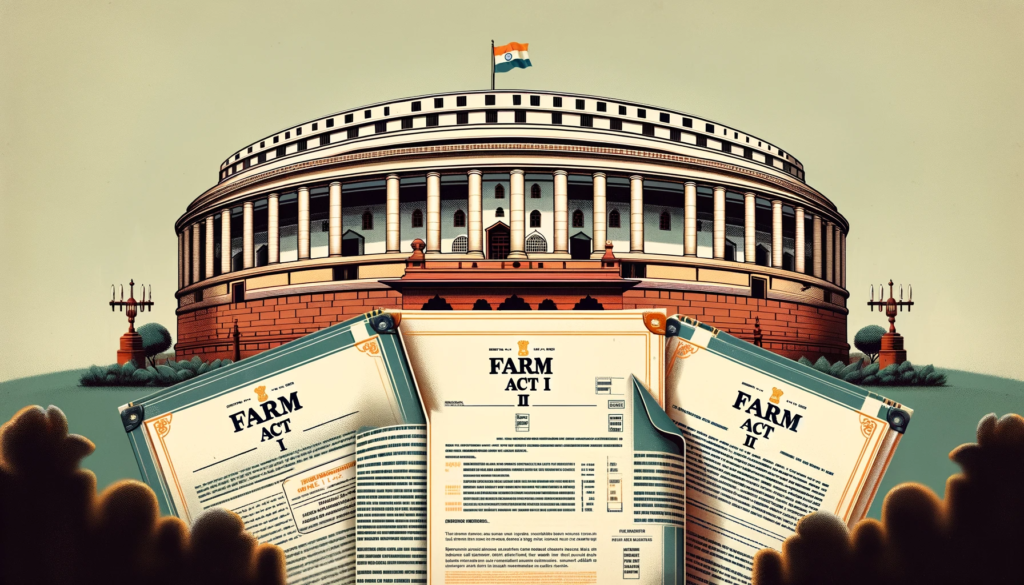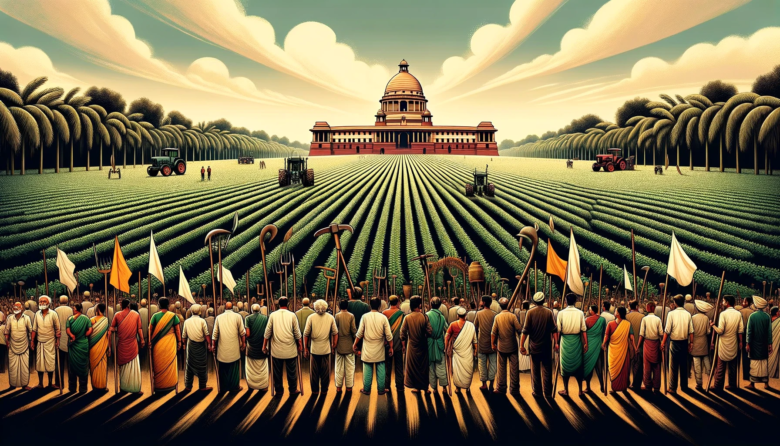The Kisan Andolan has emerged as a defining moment in India’s agrarian history, capturing the world’s attention with its scale and intensity. Sparked in 2020, this movement symbolizes the distress and defiance of Indian farmers against three contentious Farm Acts passed by the Indian Parliament. These Acts, intended to overhaul the traditional agricultural framework, have instead ignited widespread apprehension and agitation among the farming community. This blog series aims to unravel the complex tapestry of reasons that led to one of the largest farmer protests in India’s recent history.

The Three Farm Acts: Core of the Controversy
September 2020 marked a pivotal moment in Indian agriculture with the introduction of three reform bills. These Acts proposed to deregulate key aspects of the agrarian economy, allowing private corporations greater leeway in purchasing crops, stockpiling essential commodities, and engaging in contract farming.
The most contentious aspect was the absence of an obligation for these entities to pay market fees or taxes, combined with the denial of legal recourse for farmers. These changes were perceived as a direct threat to the traditional mandi system, fueling fears among farmers of plummeting crop prices and the erosion of long-standing safety nets. The apprehension was not just about the immediate economic impact but also about the long-term implications of these reforms on the agricultural sector’s structure and sustainability.

Minimum Support Price (MSP) Concerns
Central to the farmers’ apprehension was the potential impact on the Minimum Support Price (MSP), a cornerstone of India’s agricultural policy. The MSP system ensures farmers an assured price for certain crops, a critical support mechanism for small and marginal farmers. The new legislation, conspicuously silent on MSP guarantees, sparked fears of its eventual dismantlement.
This concern was particularly acute among India’s smallholder farmers, who represent the vast majority of the agricultural community. The ambiguity surrounding MSP in the new laws was seen not just as an economic threat but also as a betrayal of the government’s duty to protect the interests of its most vulnerable farmers.

Issues with Dispute Resolution and Legal Recourse
The new laws significantly altered the dispute resolution framework between farmers and buyers. Instead of traditional courts, disputes were to be handled by conciliation boards or district-level administrative officers. This shift was seen as tilting the scales in favor of big corporations and against the farmers, who often lack the resources and legal acumen to navigate these new mechanisms.
The absence of mandatory written contracts in these dealings further exacerbated the vulnerability of farmers, leaving them with limited protection and recourse in disputes. These changes in legal recourse mechanisms raised serious concerns about the erosion of farmers’ rights and their ability to seek fair redress.

Impact on Small Farmers and the Rural Economy
The epicenter of the protests was in the agriculturally dominant states of Punjab and Haryana. Here, the mandi system, a network of government-regulated markets, plays a vital role in the agricultural economy. The new laws threatened to marginalize these traditional markets, leaving small farmers vulnerable to exploitation by larger corporate entities.
There was a palpable fear that the dismantling of the mandi system would lead to an imbalance in the agricultural market, disproportionately affecting the small farmers who lack the bargaining power and resources of their larger counterparts. The potential repercussions were severe – from the loss of land and livelihoods to further exacerbation of the already critical issues of farmer debt and suicides.

Broader Implications and Government’s Perspective
While the farmers viewed these reforms as a threat, the government advocated them as a pathway to modernize agriculture and boost farmer incomes. The government’s narrative positioned these laws as liberating farmers from the constraints of middlemen and mandis, promising greater freedom and prosperity. However, this perspective was met with deep skepticism by the farming community, who perceived it as a move to favor corporate interests over their livelihoods.
Additionally, state governments faced the prospect of losing significant revenue from mandi transactions, further complicating the economic and political landscape. The broader socio-political implications were profound, reflecting growing concerns about democratic governance and the erosion of traditional livelihoods in the face of rapid modernization.

Conclusion
The Kisan Andolan transcends a mere protest against agricultural reforms; it represents a fundamental struggle for the rights and dignity of millions of Indian farmers. As we navigate through these complex layers of discontent and aspiration, we prepare to delve deeper into the actual events of the Andolan in Part 2 of this series, exploring the diverse roles and unyielding spirit that have come to define this historic movement.
Author’s Note:
Welcome to the first part of our series on the Kisan Andolan in India, a significant movement that has reshaped conversations around agriculture and democracy in the country. This piece aims to unravel the complex reasons behind this massive protest, providing a nuanced understanding of the farmers’ challenges and the socio-political context. Drawing from various sources for a well-rounded perspective, we look beyond the headlines to the human stories and systemic issues at the heart of the Andolan. Join us as we explore the intricate tapestry of events that led to one of the largest farmer uprisings in recent Indian history.
G. C., Ecosociosphere contributor.
Reference





Comments
I don’t think the title of your article matches the content lol. Just kidding, mainly because I had some doubts after reading the article.
Thank you for your sharing. I am worried that I lack creative ideas. It is your article that makes me full of hope. Thank you. But, I have a question, can you help me?